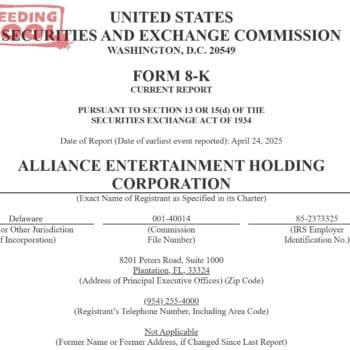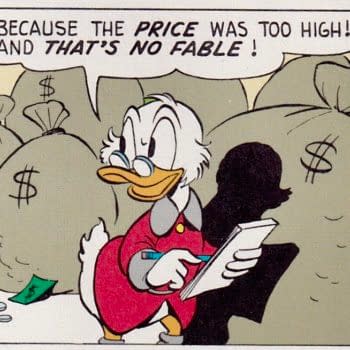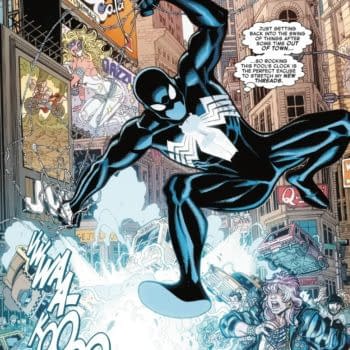Posted in: Comics | Tagged: Comics, dc, entertainment, gendercrunching, marvel
Gendercrunching – December 2012
By Tim Hanley
It was a second month of gains for the Big Two as both publishers put up strong overall numbers for female creators, with Marvel breaking records to end up in the top spot yet again. We've also got another year of stats under our belts, so we'll start to take a look at the trends at DC and Marvel.
DC COMICS
After a long mid-year slump, DC closed 2012 with one of their best months yet. In December 2012, DC Comics put out 63 new books with 568 credited creators, 497 men and 71 women. Here are their stats:
First off, I need to point out that DC moved their usual fourth week comics to the first of week of January on account of the holidays, so we're dealing with fewer books this month. Overall, DC was up 1.1% from November, which is a decent gain. Cover artists, writers, pencillers, and inkers were all down slightly, with NO pencillers whatsoever. However, colorists, letterers, and editors all rose 1-3% each, while assistant editors were up over 7%. The small losses were outweighed by the larger gains, for a net increase.
Compared To A Year Ago: DC was at 11.1% last December, so they're up 1.4% since then.
MARVEL COMICS
Last September, Marvel broke the record for the highest percentage of female creators overall, and in December they broke it again. In December 2012, Marvel released 64 new comics featuring 563 credited creators, 482 men and 81 women. Let's look at their stats:
Marvel was up 1.5% from last month, and topped the record by 0.3%, setting a new high. By category, the 50.8% female assistant editors represents the first female majority in any category in the two years we've been looking at stats. It's a record-breaking month all around! Cover artists and inkers were down slightly but everything else but letterers went up, most notably writers by over 4% and assistant editors by over 11%. It was a really strong month overall, though the lack of female artists at both publishers remains disconcerting.
Compared To A Month Ago: Marvel was only at 9.8% female creators in December 2011, so they've posted a 4.6% gain since then, a rise of nearly half!
DC COMICS – 2012 IN REVIEW
With another year of stats, we can now look back at the year as a whole. First, let's compare the full stats for 2012 to those of 2011 and see what's changed for female creators at DC:
Wow. The changes are almost non-existent, with miniscule gains and losses across the board. The biggest change was in letterers, who went up 2.2%. It's nice growth relative to their 2011 total, but 4.5% is still a pretty tiny number. Over the course of a year, you'd expect the small changes we see each month to add up to some noticeable change, but by and large the monthly ups and downs evened out and left us with the same old numbers.
On the one hand, DC was remarkably steady, and nothing's dropped precipitously. On the other hand, there was no growth whatsoever for female creators at DC Comics this year, and that's just terrible. After promises to hire more female creators in the wake of the hubbub at ComicCon 2011, it seems that DC has in fact done nothing particularly noticeable since. The gains on the creative side are negligible, where there are any, while editorial is down in both categories. All in all, it's a remarkably unimpressive showing.
So 2012 wasn't so great, but we can use the numbers to get a sense of where things might be going in 2013. First, we chart all twelve months of each category. Then we insert a line of best fit, also known as a trend line, which takes our twelve disparate points of data and gives us a straight line that shows us whether our numbers are trending up or down. This is fun because a) we can see what categories grew/shrunk the most over the course of the year, and b) it gives us a rough prediction of the way the numbers might continue to go.
BORING DETAILS: Each category is charted with its average total as its center line on the Y-axis. With every chart set up relative to its average, the trendlines of the various charts can be compared to each other. For example, if we put the numbers on the same chart layout we use each month, you'd barely even see a category like "Inkers" and it would look like there was no change there. But with each chart relative to its own average, we can look at the performance of each category on its own, and compare all the trendlines.
SUFFICE IT TO SAY: The trendlines as presented in these charts are directly comparable to each other.
So here is a super mega-chart for the percentages of women in comics at DC, overall and for each category. I'd suggest clicking it for a bigger size so as to make it readable:
Let's quickly run through the trends we're seeing with each chart:
ALL: There was some very slight growth over the course of 2012, as evidenced by the trend line going upwards just a smidge. The year ended better than it started, at least.
Cover Artists: There was a solid dip for cover artists this year, which isn't good to see.
Writers: Things are looking up for writers, though, who also ended the year with their three strongest months. That bodes well for 2013.
Pencillers: There was a bit of growth for pencillers, though the numbers are all so small across the board that the change wasn't huge.
Inkers: Inkers are similarly small, but despite being down from last year's total, overall, they're nonetheless on the rise for the year, which is a good sign for continued growth, however minimal it may be.
Colorists: There was clear, steady growth for female colorists, and with much larger numbers.
Letterers: By ending the year with their best numbers, female letterers seem poised to have a good start to 2013.
Editors: Not only did editorial slide down steadily, but the change on the trend line represents a dip of roughly 5%. It's not the steepest decline, but with such high numbers involved the losses add up quickly.
Assistant Editors: The chart shows a rather concave year for assistant editors, but the net result is a slight uptick. There's also been growth the last five months, which hopefully will continue in 2013.
Despite the lack of change compared to last year's numbers overall, 7 of the 9 categories did grow over the course of the year. Now, if you remember last year's wall of charts, a lot of the categories had a sharp decline. The New 52 put a real dent in female creator numbers, and so 2012 started out at a deficit as relative to the 2011 totals. However, things slowly improved for most categories over the course of 2012, enough to bring the yearly averages up to par with 2011. If we see the lack of female creators in the first few months of the New 52 as a hole that DC had to crawl out of, then these positive trends are an encouraging sign for 2013. DC was able to level out over the course of the year, and now things might even be on the rise. Their December numbers were certainly strong. We'll have to wait and see what happens over the next few months.
Come back next time for the January stats and Marvel's year in review!
To learn more about this statistics project and its methodology click here, and to see the previous stats click here. You can visit Tim at Straitened Circumstances and follow him on Twitter @timhanley01.


















